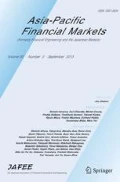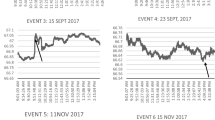Abstract
Econometric evidence on why central banks intervene in the foreign exchange market and the impact of such intervention has remained inconclusive. We contribute to the literature with evidence from India, a managed float regime that sees consistent monitoring and intervention by Reserve Bank of India, India’s central bank. Estimation of the central bank reaction function shows that increased volatility in the foreign exchange market and misalignment from targeted rates are important objectives behind intervention. The paper further uses the GARCH framework to study how intervention influences exchange rate volatility. We find that intervention in the spot market increases volatility while that in the forward market reduces volatility.


Similar content being viewed by others
Notes
The motivations behind ‘leaning against the wind’ and ‘leaning for the wind’ policies are different. In the former case, central bank attempts to reverse the direction of exchange rate movement while in the latter the motive is to reduce the extent of volatility only.
Exchange rate is defined as number of domestic currency units for one unit of foreign currency.
Nominal effective exchange rate is the weighted averages of bilateral exchange rates of domestic currency in terms of foreign currency and REER is the weighted average of NEER adjusted by the ratio of domestic price to foreign prices. The weights for the 36-currency Trade based REER (Export based REER) index are based on the normalized geometric average of India’s bilateral trade (exports) with countries/regions represented by the 36 currencies during the preceding three years (RBI 2005).
References
Akinci, Ö., Culha, O., Ozlale, Ü., & Şahínbeyoğlu, G. (2005). Causes and effectiveness of foreign exchange interventions for the Turkish economy. Central Bank of Turkey, Research Department working paper.
Archer, D. (2005). Foreign exchange market intervention, methods and tactics. In Bank for International Settlements (Ed.), Foreign exchange market intervention in emerging markets, motives, techniques and implications, pp. 40–55.
Baillie, R., & Osterberg, W. (1997). Why do central banks intervene? Journal of International Money and Finance, 16, 909–919.
Behera, H., Narasimhan, V., & Murty, K. N. (2008). Relationship between exchange rate volatility and central bank intervention: An empirical analysis for India. South Asia Economic Journal, 9, 69–84.
Beine, M., Bénassy-Quéré, A., & Lecourt, C. (2002). The impact of central bank interventions, new evidence from figarch estimations. Journal of International Money and Finance, 21, 115–144.
Beine, M., Janssen, G., & Lecourt, C. (2009). Should central bankers talk to the foreign exchange markets? Journal of International Money and Finance, 28(5), 776–803.
Beine, M., Laurent, S., & Lecourt, C. (2003). Official interventions and exchange rate volatility: New evidence from a switching regime analysis. European Economic Review, 47, 891–911.
Beine, M., Lahaye, J., Laurent, S., Neely, C., & Palm, F. (2007). Central bank intervention and exchange rate volatility: Its continuous and jump components. International Journal of Finance and Economics, 12(2), 201–223.
Bordo, M., Humpage, O., & Schwartz, A. (2012). The Federal Reserve as an Informed Foreign Exchange Trader: 1973–1995. International Journal of Central Banking, 8(1), 127–160.
Chen, Y. F., Funke, M., & Glanemann, N. (2013). The signalling channel of central bank interventions: Modelling the Yen/US dollar exchange rate. Open Economies Review, 25(2), 311–36.
Disyatat, P., & Galati, G. (2005). The effectiveness of foreign exchange intervention in emerging market countries: Evidence from the Czech Koruna. Bank for International Settlements, working paper no. 172, http://www.bis.org/publ/work172.htm.
Dominguez, K. (1998). Central bank intervention and exchange rate volatility. Journal of International Money and Finance, 17, 161–190.
Dominguez, K., & Frankel, J. (1993) Does foreign exchange intervention work? Institute For International Economics.
Dua, P., & Ranjan, R. (2010). Exchange rate policy and modelling in India. RBI Development Research Group, Study No. 33. http://Rbidocs.Rbi.Org.In/Rdocs/Publications/Pdfs/DRS33250210.Pdf. 08/07/2014.
Edison, H. (1993). The effectiveness of central-bank intervention. A survey of the literature after 1982. Special papers in international economics. Princeton University.
Edison, H., Cashin, P., & Liang, H. (2006). Foreign exchange intervention and the Australian dollar: Has it mattered? International Journal of Finance and Economics, 11, 155–171.
Fatum, R., & Hutchison, M. (2003). Is sterilised foreign exchange intervention effective after all? An event study approach. The Economic Journal, 113, 390–411.
Fatum, R., & King, M. (2005). Rules versus discretion in foreign exchange intervention: Evidence from official bank of Canada high-frequency data, working paper Santa Cruz center for international economics, working paper no. 04-24. http://www.econ.ku.dk/epru/files/wp/wp-05-06.pdf.
Frenkel, M., Pierdzioch, C., & Stadtmann, G. (2005). The effects of Japanese foreign exchange market interventions on the Yen/U.S. dollar exchange rate volatility. International Review of Economics & Finance, 14(1), 27–39.
Goyal, A., & Arora, S. (2012). The Indian exchange rate and central bank action. An EGARCH analysis. Journal of Asian Economics, 23, 60–72.
Hillebrand, E., & Schnabl, G. (2004). The effects of Japanese foreign exchange intervention: GARCH estimation and change point detection. International Finance 0410008, EconWPA.
Humpage, O. (1986). Exchange market intervention: The channels of influence. Economic Review, 22, 2–13.
Ito, T., & Yabu, T. (2004). What promotes Japan to intervene in the foreign exchange market? A new approach to a reaction function. Journal of International Money and Finance, 26, 193–212.
Ito, T. (2003). Is foreign exchange intervention effective? The Japanese experience in the 1990s. In P. Mizen (Ed.), Essays in honour of Charles Goodhart: Monetary history, exchange rates and financial markets (Vol. 2). Cheltenham: Edward Elgar.
Jalan, B., (2003). Exchange rate management—An emerging consensus? In Address at the 14th national assembly of the Foreign Exchange Association of India, Mumbai, 14 August.
Jurgensen, P. (Chairman). (1983, March). Report of the working group on exchange market intervention. Washington D.C.: U.S. Treasury Department.
Khan, H. (2012). Managing currency and interest rate risks—New challenges for banks and corporates. Keynote address at 2nd FT-Yes Bank International Banking Summit, Mumbai.
Khan, H. (2014). Indian foreign exchange market, recent developments and the road ahead. In Inaugural address at the 25th annual foreign exchange assembly organized by the Foreign Exchange Association of India (FAI), Gurgaon.
Kim, S., & Sheen, J. (2002). The determinants of foreign exchange intervention by central banks: Evidence from Australia. Journal of International Money and Finance, 21, 619–649.
King, M. (2003). Effective foreign exchange intervention, matching strategies with objectives. Journal of International Finance, 6(2), 247–269.
Neely, C.J., & Weller, P.A. (2007). Central bank intervention with limited arbitrage, federal reserve bank of St. Louis, working paper 2006–033B. http://research.stlouisfed.org/wp/2006/2006-033.pdf.
Mohan, R. (2006). Central banks and risk management: Pursuing financial stability. RBI Bulletin, December (2006), 1505–1516.
Mundaca, G. (2001). Central bank interventions and exchange rate bands regimes. Journal of International Money and Finance, 20, 677–700.
Neely, C. (2002). The temporal pattern of trading rule returns and central bank intervention: Intervention does not generate technical trading rule profits. Journal of International Economics, 58, 211–232.
Neely, C. (2006). Authorities’ beliefs about foreign exchange intervention: Getting back under the hood. Federal Reserve Bank of Saint Louis, working paper no. 2006-045A.
Obstfeld, M., & Rogoff, K. (1996). Foundations of international macroeconomics. Cambridge, MA: MIT Press.
Ramaswamy, R., & Samiei, H. (2000). The yen-dollar rate, have interventions mattered? International Monetary Fund, working paper no. 00/95.
Reddy, Y. V. (1997). Exchange rate management: Dilemmas. In Inaugural address at XIth national assembly Foreign Exchange Association of India, Goa
Reddy, Y. V. (1998). Emerging scenario in foreign currency management. Key note address at the CII seminar, Mumbai.
Reserve Bank of India. (2005). Revision of nominal effective exchange rate (NEER) and real effective exchange rate (REER) indices. www.rbi.org.in. 12/06/2014.
Reserve Bank of India. (2014). Database and notifications. www.rbi.org.in. 12/06/2014.
Rogoff, K. (1984). On the effects of sterilized intervention: An analysis of weekly data. Journal of Monetary Economics, 14, 133–150.
Roy, A. (2014). Rupee overvalued based on real effective exchange rate. LiveMint. Oct 08 2014.
Sarno, L., & Taylor, M. (2001). Official intervention in the foreign exchange market: Is it effective and if so, how does it work? Journal of Economic Literature, 39, 839–868.
Taylor, M. (2005). Official foreign exchange intervention as a coordinating signal in the dollar–yen market. Pacific Economic Review, 10, 73–82.
Acknowledgments
The authors thank the editor and two anonymous referees for useful comments and suggestions. The views and opinions expressed in the paper belong to the authors and do not, in any way, reflect the views of the institutions the authors represent.
Author information
Authors and Affiliations
Corresponding author
Additional information
P. G. Apte: Formerly Adjunct Professor, NIBM and Director, Indian Institute of Management Bangalore (IIM-B).
Rights and permissions
About this article
Cite this article
Roy Trivedi, S., Apte, P.G. Central Bank Intervention in USD/INR Market: Estimating Its Reaction Function and Impact on Volatility. Asia-Pac Financ Markets 23, 263–279 (2016). https://doi.org/10.1007/s10690-016-9218-6
Published:
Issue Date:
DOI: https://doi.org/10.1007/s10690-016-9218-6
Keywords
- Central bank intervention
- Exchange rate volatility
- Foreign exchange markets
- GARCH analysis
- Intervention reaction function




